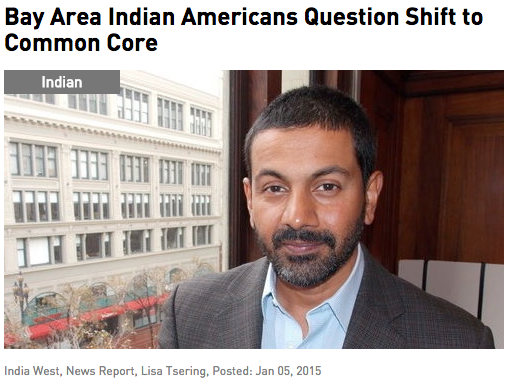
A foundation’s media partnership helps reach ethnic communities
This post is one in a series on what four community and place-based foundations are learning by funding media projects that help to meet their local information needs. All are funded through the Knight Community Information Challenge.
Great storytelling ability typically isn’t a top skill found among managers and staff of community foundations. But, of course, it’s second nature to most journalists.
As community foundations focus on creating better “informed communities,” many face choices about how to add storytelling skills to their organizations’ repertoire. Do foundation leaders hire creative people for newly created positions devoted to community information and news? Do they train existing staff to become exemplary storytellers? Rely on freelancers? Or do they look to outside partnerships and programs, where journalists and other creatives are funded to help achieve the foundation’s goals?
The Silicon Valley Community Foundation is experimenting with the latter model. When I last wrote about the foundation and its Informed Communities Education Reporting Fellowship program late last year, nine journalists from ethnic news outlets had just begun to cover how Common Core, the new national standards for K-12 students, is being implemented in local schools, and how teachers, students, and parents are coping. The fellows’ reporting is being funded by the Silicon Valley Community Foundation, which has a Common Core initiative, and is supported by New America Media, another foundation grantee.
As the journalism fellows program hits its stride, the journalists’ work is succeeding in getting information out and generating discussion about Common Core in communities that hadn’t been part of the conversation and that for the most part don’t consume local mainstream media, says Neha Singh Gohil, senior media fellow for Silicon Valley Community Foundation. Most of the ethnic-media outlets where the fellows work have not covered Common Core until now, nor do they have dedicated education reporters, she points out. All of the reporting fellows had to learn about Common Core from scratch.
Each fellow is required to produce at least four articles or other type of content on the subject of Common Core and local education issues before the fellowship ends in June. The hope is that the community journalists will go further because they have been exposed to a wealth of new education-related local story ideas.
At this writing, coverage has ranged from TV reports by fellow Melissa Hernandez on Univision14, the San Francisco Bay Area’s Spanish-language news leader, to news articles by fellow Giang Phan for Cali Today, a newspaper and news website published for the local Vietnamese population. (You can view all of the work published so far on this page on New America Media’s website. Fellows’ reporting also is found via Embrace the Core, an informational website designed for reaching and engaging with educators and school administrators.)
Reporting fellow Lisa Tsering is covering Common Core to inform the Indian population in Silicon Valley.
To the obvious question about possible foundation motives for paying to get local journalists to cover Common Core, which is not without controversy, Gohil reassures that the fellows “were given no guidance or instructions on the direction of their stories.” The foundation did encourage the fellows to make their journalism specific to their respective ethnic audiences. As Gohil explains, the foundation is not interested in general stories about what Common Core is about, but wants to see more local, contextual reporting that’s community-specific. An example of this is the story “For Chinese Parents, Traditional Methods Best Prep for Common Core” by fellow David Wang for Sing Tao USA, the American edition of one Hong Kong’s largest newspapers, The article explores the way Chinese parents are coping with the curriculum changes.
One way that the foundation has kept clear of influencing the fellows’ reporting is by involving the San Francisco-based New America Media, which advocates for 3,000-plus ethnic news organizations across the U.S. New America’s Peter Schurmann is the primary support person for the journalist fellows, and works closely with Gohil. He, too, steers clear of influencing the direction of fellows’ Common Core-related stories, but does help the reporters with understanding the topic better, since they lack expertise in education reporting; ensuring factual accuracy; and assisting them when necessary with language issues that arise in reporting and writing, since English is many of the fellows’ second language. Schumann also participates in fellow trainings, which sometimes include education experts, principals and teachers dealing with the transition to Common Core at their schools.
So far, the fellows’ output has been what you might call conventional. Besides the news articles and TV-news reports, there is fellow Celina Rodriguez’s three-part radio series examining Common Core, and fellow Henrietta Burroughs’ video panel discussions of Common Core which are being aired on KMVT15 Community Media and published at East Palo Alto Today. Soon to be published is the Common Core photojournalism coverage by fellow Rian Dundon, an Oakland-based photographer.
Alternative forms of storytelling, especially for digital interactive media, are not yet a priority, although innovative and more-powerful forms of presenting news and information about Common Core and future community-reporting initiatives are on Gohil’s radar.
The Silicon Valley reporting initiative should continue to be worth watching as a promising way for community foundations to bolster local news entities and allow them to expand their coverage of important local issues, all while working toward the goal of creating better informed communities.
Steve Outing is a writer and digital media consultant.
Recent Content
-
Community Impactarticle ·
-
Community Impactarticle ·
-
Community Impactarticle ·


